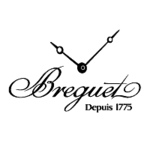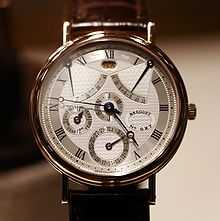Breguet (watch)
 | |
| Type | Member of the Swatch Group |
|---|---|
| Industry | Watch manufacturing |
| Founded | 1775 by Abraham-Louis Breguet |
| Headquarters | Vallée de Joux, Switzerland |
| Key people | Abraham-Louis Breguet, founder |
| Parent | The Swatch Group |
| Website | breguet.ch |


Breguet is a Swiss manufacturer of luxury watches, founded by Abraham-Louis Breguet in Paris in 1775. Currently part of The Swatch Group, its timepieces are now (since 1976) produced in the Vallée de Joux in Switzerland. It is one of the oldest surviving watch-making establishments and is the pioneer of numerous watch-making technologies, the most notable being the tourbillon, invented by Abraham-Louis Breguet. It also produced the first wrist watch in 1810.[1]
Breguet introduced a line of writing instruments as a tribute to writers who mention or feature Breguet watches in their works.
Breguet watches are often easily recognized for their coin-edge cases, guilloché dials and blue pomme hands (often now referred to as 'Breguet hands').
History
Breguet was founded in 1775 by Abraham-Louis Breguet. His first known address was at 51 Quai de l'Horloge on the Île de la Cité in Paris. Thanks to his marriage to the daughter of a prosperous French bourgeois, her dowry provided the backing which allowed him to open his own workshop. The connections Breguet had made with scholarly people during his apprenticeship as a watchmaker and as a student of mathematics soon paid off. Following his introduction to the court, Queen Marie Antoinette grew fascinated by Breguet's unique self-winding watch; Louis XVI bought several of his watches and legend has it that Marie Antoinette commissioned the watch that was to contain every watch function known at that time – Breguet's masterpiece, the Marie Antoinette (No. 160).
The business grew from strength to strength, and around 1807 he took on his son Louis Antoine as his partner, and the firm then became known as Breguet et Fils. After Abraham-Louis Breguet died in 1823 the firm carried on under his son Louis-Antoine. After Louis-Antoine retired in 1833 (he died in 1858) the business continued under Abraham-Louis' grandson Louis Clément Francois (1804–1883). Abraham-Louis' great-grandson Louis Antoine (1851–1882) was the last of the Breguet family to run the business. Although he had two sons and a daughter, they did not enter the business, so Breguet took on noted English watchmaker Edward Brown of Clerkenwell to look after the Paris factory. Brown eventually became a partner and, after Breguet's death, the owner and head of the company. When Brown died in 1895 the firm was taken over by his sons Edward and Henry. On Edward's retirement in the early 1900s, Henry Brown became the head of the firm.[2]
Contemporary production
Gentlemen's:
- Classique: Simple, Grandes Complications – popular round pieces, usually with reeded bezels and soldered lugs
- Marine – water-resistant, distinguished by the presence of crown guards.
- Heritage – tonneau-shaped cases
- Type XX,XXI – sturdy chronographs, based on World War II-era pilots' watches.
- La Tradition – similar to the long gone Souscription by Breguet, open-faced watches with the movement on the front, along with a small face
Women's: (mainly distinguished by diamonds)
- Classique
- Marine
- Heritage
- Type XX
- Reine de Naples – oval bezels
Breguet's distinguished patrons
- Louis Philippe I, Duke of Orléans (1780)
- Marie-Antoinette, Queen of France (1782)
- Louis XVI, King of France (1783)
- Charles de Choiseul-Praslin, Duc de Choiseul-Praslin
- Charles Maurice de Talleyrand-Périgord, 1st Sovereign Prince of Beneventum (1787)
- Marie Jean Antoine Nicolas de Caritat, Marquis de Condorcet (1792)
- Joséphine de Beauharnais, French Empress (1798)
- Napoleon Bonaparte, French Emperor (1798)
- General Charles Victor Emmanuel Leclerc, (1801)
- George Augustus Frederick, Prince of Wales, later George IV (1803)
- Giovanni Paisiello, Italian composer (1804)
- William, Prince of Wurttemberg, later William I of Württemberg (1805)
- Louis Antoine de Bougainville, French explorer
- Selim III, Sultan of the Ottoman Empire (1806)
- Caroline Murat, Queen of Naples (1807)
- Tsar Alexander I of Russia (1809)
- George III, King of England (1810)
- Duke of Infantado, General and main Spanish opponent of Napoleon Bonaparte.
- Prince Alexey Fyodorovich Orlov (1810)
- Prince Stanisław Poniatowski, Polish Prince (1811)
- Prince Ferdinand of Spain, later Ferdinand VII of Spain (1812)
- Infante Carlos, Count of Molina, Prince of Spain (1812)
- Baron Jean-Conrad Hottinguer, Swiss banker (1812)
- Michel Ney, Marshal of France (1813)
- Archduchess Maria Luisa of Austria, Empress of France (1813)
- Arthur Wellesley, 1st Duke of Wellington (1814)
- George Spencer-Churchill, 6th Duke of Marlborough (1818)
- Henry Howard, 13th Duke of Norfolk (1821)
- Louis XVIII, King of France (1821)
- Count Axel von Fersen, Swedish diplomat (1835)
- Queen Victoria (1838)
- George Washington, 1st American President
- Charles Auguste Louis JosParis (1863)
- Isabel of Orleans-Braganza, Princess Imperial of Brazil (1871)
- Sir Winston Churchill, British Prime Minister (1901)
- Fuad I, was the Sultan and later King of Egypt and Sudan, Sovereign of Nubia, Kordofan, and Darfur. (1924)
- Arthur Rubinstein, Master pianist (1930)
- Sergei Rachmaninoff, Composer (1931)
- Ettore Arco Isidoro Bugatti, founder of the automobile company (1932)
- Prince George of Greece and Denmark (1934)
- Edward VIII, later The Duke of Windsor (1950)
- Mohammed Salih Hagos, Eritrean Ambassador to Switzerland (1953)
- Lola Astanova, Virtuoso pianist
- Nicolas Sarkozy, French president
- Arkady Krichevets, Russian billionaire [citation needed]
- Dmitry Medvedev, Russian president
- Parvez Kader, Indian billionaire
- Leo Tolstoy, Russian author
- Aristotle Onassis, Greek shipping magnate
- Aditya Bikram Shah, Shah Organisation, Nepal
- Victor Hugo, writer
- Charles, Prince of Wales, British heir apparent to the throne
- Valery Gergiev, Russian musician.
- Kirill I of Moscow, Patriarch of Moscow and All Russias conceivably wear model 5188.
- Olek Boyko, investor, Kiev
- Ainārs Šlesers, Vice-Mayor of Riga, Latvia
Fictional owners
- Dr. Lorrain, famous Petersburg doctor, in Leo Tolstoy's War and Peace
- Hadji Murad, in Leo Tolstoy's Hadji Murad
- Dr. Stephen Maturin in Patrick O'Brian's Aubrey–Maturin series
- Baron Danglars from Dumas' The Count of Monte Cristo
- Viscount Albert de Morcerf from Dumas' The Count of Monte Cristo
- Eugene Onegin in Alexander Pushkin's Eugene Onegin
- Gerald Duncan in Jeffery Deaver's "The Cold Moon"
- Col. Gudin in Bernard Cornwell's "Sharpe's Tiger"
- Nicholas Fandorin in Boris Akunin's series of adventure novels. The watch was a gift from the Czar (King).
- Eugène de Rastignac in Honoré de Balzac's Le Père Goriot. The watch was a gift from Goriot's daughter, Delphine.
- Monique Lamont in the Win Garano series by Patricia Cornwell
- Wealthy investor Carl Van Loon, portrayed by Robert De Niro, in the 2011 film, "Limitless"
- Danny Chavasse in Peter O'Donnell's Last Day in Limbo and Cobra Trap/Dark Angels [Modesty Blaise]
- Major Henri Dulong in Bernard Cornwell's "Sharpe's Havoc"
Trivia
- Breguet offered a piece to navigator Bougainville as he was organizing his great expedition to the North Pole.
- Member of the American Watch Guild
References
- Breguet 1747–1823 – online edition of the seminal 1921 biography by Sir David Salomons, hosted by Archive.org
- ↑ "Histoire de la Maison Breguet", Tendance Horologie, 16 April 2009 (French)
- ↑ Salomons, 1921, pp.7–8
External links
| Wikimedia Commons has media related to Breguet (watch). |
| |||||||||||
